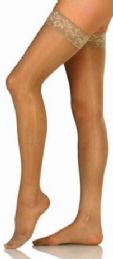~2.jpg&newheight=260&quality=80)
.jpg&newheight=260&quality=80)
~1.jpg&newheight=260&quality=80)

What are Diabetic Socks?
Diabetic socks are available in a variety of configurations, styles and sizes to suit the specific individual needs of both men and women. They are most often constructed in a non-elasticized, non-binding formation, comprised of materials that are more highly effective at controlling and wicking away moisture than regular socks. The specialized, seamless design additionally helps to reduce pressure points, preventing blisters, ulcers and irritation.
Diabetic socks often look like regular socks, and many different styles are obtainable, such as low-cut, mid-calf and pantyhose styles. They are usually made from the most comfortable, moisture-resistant fabrics and materials that include bamboo, cotton, wool and specialized synthetic/acrylic blends. Some fabric blends incorporate silver and other antimicrobial agents to prevent infections.
While most diabetic socks are non-restrictive, there are some designs that do weave in light compression properties to gently address edema and swelling, but will not hinder circulation in the process. Diabetic socks are generally more effective when they are form-fitting, rather than tube sock designs. Other features to look for include non-constricting cuffs, a seamless construction and other non-binding attributes. The capability of the socks to wick away moisture and to keep the feet warm and dry is another important consideration. Extra-wide sock tops are an appropriate choice for excessive edema issues.
What are the Benefits of Wearing Diabetic Socks?
While diabetic socks are specifically intended for use by diabetics, they can also be used and enjoyed by non-diabetics as well. Anyone who tends to have problems with their feet such as swelling, fungus and other infections, pain, sweating and poor circulation can benefit from the use of diabetic socks.
Because diabetes is a condition that raises blood sugar levels, this higher concentration of glucose in the blood can lead to poor circulation as it results in blood vessel and nerve damage. The feet are generally the first affected part of the body from this condition, and many people with diabetes develop diabetic neuropathy, or nerve damage in their feet. This creates a loss of sensation, which is why it is crucial for diabetics to check their feet every day to ensure that problems are not developing that they simply cannot feel. If left unchecked, minor problems can turn into much more serious and devastating problems, including amputation.
Diabetic socks can be quite a boon in helping to treat existing problems, and to reduce the occurrence of new foot problems. The process of wound healing takes much longer in some people with diabetes, so avoiding and preventing blister, wound and pressure ulcer formation is the best treatment protocol for diabetics.
Diabetic socks can help diabetics and other individuals with these common features:
Moisture-wicking: Crucial for the prevention of skin infections like fungus, the ability of the socks to wick away moisture from the skin and keep the feet dry is one of the most important aspects that good quality diabetic socks offer.
Fitted construction: Most experts recommend that diabetic socks conform to the foot and leg as this aids in the prevention of loose fabric rubbing and irritating the skin, leading to tissue breakdown and more involved problems. However, the socks should never feel tight, as their main purpose is to be non-constrictive in a non-elasticized format to encourage better circulation.
Seamless design: Most diabetic socks are made in a seamless format because seams can rub too much against the skin, resulting in blisters, ulcers and other skin irritations.
Square toe box: Many diabetic sock designs allow for more room around the toes, as socks that fit tightly around those areas create moisture buildup between toes, along with discomfort and irritation.
Warmth: Because diabetics and others can tend toward cold feet because of compromised circulation, keeping the feet warm is another important feature of a good diabetic sock design.
Padding: Specially designed padding can provide enhanced comfort, cushioning and protection from injury.
Rehabmart is pleased to extend a comprehensive selection of diabetic socks to our customers from superior quality manufacturers that include EcoSocks, Independence Medical, Salk Inc., BSN Medical and Juzo.
Hulet Smith, OT
Rehabmart Co-Founder & CEO
ck